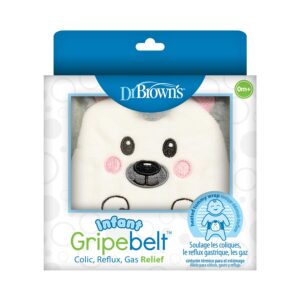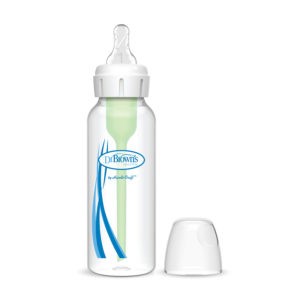For parents, it can be incredibly frustrating and exhausting to not know why your baby is crying, or how to comfort them.
Parents often use the term “colic” freely when talking about a baby who seems to cry a lot. Many times, persistent fussiness can be a sign or symptom of something else—like allergies or reflux. But colic is a medical term, with specific clinical criteria to define the condition. To get the right treatment plan, it’s important to differentiate between a baby who seems cranky, and one who truly has colic.
To help determine whether you’re dealing with colic or crankiness, take a deep breath and ask yourself these questions:
- When does your baby get fussy?
- Can your baby be comforted?
- How long have symptoms been going on?
- Decrease sensory stimulation. With colicky babies, their crying tends to worsen in overstimulated environments. Try turning the TV off, dimming the lights, and putting on white noise or soft music.
- Swaddle your baby. The tightness of the blanket provides security and warmth similar to that of the uterus. Swaddle belts can help ease gas while providing this tight, swaddled feeling.
- Rock your baby back and forth. During pregnancy, babies enjoy the gentle motions of their birth parents’ moving and walking, which is why many newborns are soothed by vibrating chairs or swings. Hold your baby securely in your arms and gently swing back and forth. Or, “wear your baby” against your body with a baby carrier or wrap, and move in a rocking manner. The swinging motion can provide comfort and distraction.
- Stop hunger before it hits. Learn your baby’s hunger cues and feed them before they start to cry. Crying can add air to their stomach, making your baby gassier and more uncomfortable.
- Choose the best products. Invest in products that help prevent or reduce gas that can worsen crying spells. Dr. Brown’s Natural Flow® Anti-Colic Options+™ Baby Bottles do just that. Their Options+™ Bottles have an internal vent system that routes the air away from the milk. This system helps to reduce air bubble oxidation, helps to prevent gas, and preserves the vitamins in the milk.
When it comes to colicky vs. cranky, the time of day your baby is fussy may be a clue to what is really going on.
Babies who feel cranky will become fussy any time of the day—often, shortly after eating, when overly tired, overstimulated or simply hungry.
Although babies with colic can cry throughout the day as well, the late afternoon is the hardest time of day for colicky babies. It’s often in the late afternoon when their crying and fussiness gets significantly worse. That’s when parents notice their babies become inconsolable.
The ability to soothe your baby’s cry can be another indication of colic vs. crankiness. Babies with colic tend to be extremely difficult to soothe. They seem easily irritated and overstimulated by their environment.
Cranky babies tend to be soothed once the reason for their crankiness is addressed or they are distracted from the problem at hand—for example, when their diaper is changed, or they’re fed or put to sleep.
With colic, the cry is relentless, and it’s very difficult to provide comfort for your baby. Throughout the day, colicky babies become even more tired and irritable. You might find that their inconsolable cry tends to be louder and higher pitched as the day goes on.
This added stress can lead to the parents or caregivers feeling overwhelmed, inadequate, and depressed over not being able to soothe their baby. For this reason, I’d like to stress that it’s so important for parents to understand that colic is not a sign of an unhappy baby. You are not doing anything wrong. The tears of a colicky baby have nothing to do with what you aren’t doing right or what you’re “lacking” as a caregiver. They have everything to do with a real clinical diagnosis and the fact that your child is experiencing a true medical condition.
Colic is often defined by the “rule of 3“: crying for more than 3 hours per day, for more than 3 days per week, and for longer than 3 weeks, in an infant who is well-fed and otherwise healthy.
The amount of time your baby has been experiencing these symptoms may help determine whether they have colic or are simply fussy. For most colicky babies, symptoms begin to lessen and eventually subside by age 3-to-4 months. If symptoms appear to worsen during or after this timeframe, reflux could also be a possible culprit. It is estimated that by 4 months of age, 80-to-90 percent of infants no longer suffer from colic.
Develop a Colic Comfort Plan
Although there is no definitive medical treatment for colic, there are techniques proven to be helpful. You’ll notice that many of the methods we use to soothe a baby with colic emulate the environment of the womb.
Diagnose and Take Action
If your newborn is crying on a consistent basis or is unable to be soothed, it is important to have your baby evaluated by a pediatrician. Many conditions—such as reflux, formula intolerance, or milk allergies—can lead to discomfort and persistent crying. Work with your pediatrician to rule out any conditions that should be treated with medication.
If you review your baby’s symptoms, and your pediatrician agrees on a diagnosis of colic, you can find comfort in the fact that “this too shall pass.” You’re a great parent with a great baby who is experiencing a tricky, but temporary, uncomfortable condition. With the support of your pediatrician and colic-comfort methods, you’ll make it through together.
About the author:
Dr. Katie Friedman is a board-certified pediatrician, writer, spokesperson, and mother. Dr. Friedman completed her residency at Jackson Memorial Hospital at the University of Miami. She currently practices pediatric emergency medicine in South Florida. She divides most of her working hours between the emergency room and the blog she created with her sisters, ForeverFreckled.com, where she serves as an educator and spokesperson.
Using her passion for preventive medicine and pediatric safety, Dr. Friedman has worked alongside several brands and companies, to guide parents through obstacles of childhood safety, illness prevention, and pediatric medicine. In addition to her hospital work and writing obligations, she also serves as a medical correspondent for Lifetime’s Access Health and The Balancing Act. In her free time, Dr. Friedman loves spending time with her family, traveling, and early morning runs.



